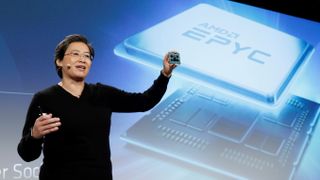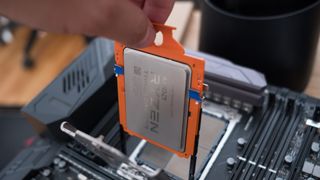Intel’s new processors go all-in on power and performance – but is that leaving an open goal for AMD?
Is Intel in an impossible position?

Intel revealed its much-anticipated 10th generation Comet Lake-S desktop processors earlier this week, but rather than having a big, bombastic, launch, the company went for a more low-key approach.
While that could mainly be due to the ongoing global situation – now is hardly the time to have a huge launch event packed with people – the fact that Intel marked the launch of its Comet Lake-S processors with a simple press release, and not even a livestream, seems to betray a lack of confidence in these chips.
This is for two reasons. First of all, we’ve been waiting for 10th generation desktop CPUs from Intel for a while now, so their arrival should have been cause of celebration.
Secondly, Intel’s old rival, AMD, has been on a hell of a roll recently. Only recently, AMD’s chief executive Lisa Su boasted that the company accounts for “more than 50% of premium processor sales at many top global etailers”, with Ryzen 2000 and 3000 chips being singled out as being singled out for their strong performance.
With an increasingly bullish AMD, we’d have expected Intel to come out all guns blazing to show everyone that it’s still the top dog when it comes to processors, rather than the slightly muted launch we saw.

Going for performance
However, while the Comet Lake-S launch was a bit on the quiet side, there was still some of that good old Intel bravado we’re used to. As the company proudly claimed, the flagship Intel Core i9-10900K is being billed as the “world’s fastest gaming processor.”
By focusing on its flagship CPU – which isn’t just the most powerful of the 10th gen desktop processors, but also the most expensive – it seems Intel is aiming this launch squarely at gamers and enthusiasts.
Get daily insight, inspiration and deals in your inbox
Get the hottest deals available in your inbox plus news, reviews, opinion, analysis and more from the TechRadar team.
And, while Intel actually announced an impressive range of new processors, spanning i3, i5 and i7 iterations, as well as Pentium and Celeron CPUs for budget builds, it’s focus on the i9 CPU, I feel, spoke volumes about its current plans.
It really seems to want to hold on to the high-end market, proving to gamers and enthusiasts with deep pockets for the latest tech that if you want the best performing CPU for gaming and content creation, and are happy to indulge in some overclocking, then Intel is still the company to go for.
Even the tweaks Intel has made to its other non-flagship processors seem to bear this out, in my view.
Every unlocked CPU in the i5 – i9 range now has a Thermal Design Power of 125W. That’s a substantial increase in TDP from the previous generation, which were 95W.
Increasing the TDP of the CPU undoubtedly allows Intel to boost the performance of the new chip, but it comes at a cost. There’s an impact to your energy bills, for example, and the extra heat produced could require an upgrade to your cooling system.
For gamers and enthusiasts, where performance is king, having to splash out on a new cooling system or PSU is all part of the process in squeezing every last drop of performance out of your PC.
Intel also seems to think this is a price worth paying for increased performance, but mainstream – and certainly people on a budget – will likely disagree.
Intel’s pursuit of enthusiasts is understandable – its a market it’s usually had no problem winning over, and the claim of having the ‘fastest gaming processor’ in the world is certainly an eye-catching one. But does that mean its leaving the mainstream and budget markets all to AMD?

AMD on the rise
When it comes to sheer price and performance, AMD has been absolutely knocking it out of the park recently. Its Ryzen 3000 processors (which Intel’s new Comet Lake-S chips are directly competing with) offer excellent performance for prices that Intel seems uninterested to compete with.
They might not quite reach the performance of some of Intel’s latest chips, but they are more affordable. They are also more energy-efficient, and-crucially for many people – if you have a motherboard for the older Ryzen 2000 chips, there’s a good chance it’s compatible. That means if you upgrade your processor, you don’t need to buy a new motherboard as well.
Meanwhile, Intel’s new CPUs require a new Z490 motherboard – adding a considerable extra expensive.
If you want a budget PC with the best possible performance, then, AMD still seems to be the best choice. But Intel is Intel really happy with ceding budget and mainstream markets to AMD?
Perhaps not, but that seems to be happening.

Going for the high end
That’s not Intel’s only problem. While going for the enthusiast and gaming markets makes sense, AMD is also doing really well there as well.
Ryzen 7 and Ryzen 9 CPUs are finding big fans with gamers, and while they might not be as budget-conscious as mainstream and budget customers, many people are cottoning on to the fact that if you spend less on upgrading your CPU, then you have more money to spend on upgrading other parts of your rig – or more cash to buy more games.
And for enthusiasts, AMD’s Threadripper range is winning them over. The AMD Ryzen Threadripper 3990X, for example, is a 64-core beast that when overclocked to 5.5Ghz smashed world records.
That’s the kind of product that’s absolute cat-nip to enthusiasts that want the absolute best performance, and in true AMD style, it’s for a price that seriously undercuts any comparable Intel processor (it’s still mighty expensive, though).
By doubling down on this market, if AMD starts to claw away at its dominance, Intel could be in real trouble.
There’s little doubt that Intel’s new Comet Lake-S processors are going to be decent processors, but we’ve been waiting for a while now for the company to unveil products that blow AMD out of the water in every category.
Sadly, it seems we’re still waiting. But Intel has to be aware that AMD isn’t hanging around.
- These are the best CPUs of 2020

Matt is TechRadar's Managing Editor for Core Tech, looking after computing and mobile technology. Having written for a number of publications such as PC Plus, PC Format, T3 and Linux Format, there's no aspect of technology that Matt isn't passionate about, especially computing and PC gaming. Ever since he got an Amiga A500+ for Christmas in 1991, he's loved using (and playing on) computers, and will talk endlessly about how The Secret of Monkey Island is the best game ever made.
